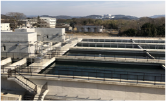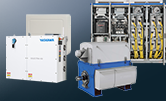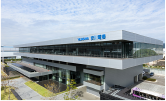Disclosures based on TCFD
The Yaskawa Group announced its endorsement of the TCFD recommendations in September 2019, and in September 2020, the Group implemented various initiatives, including participation in the Ministry of the Environment’s project to support scenario analysis of climate risks and opportunities in line with the TCFD. In May 2021, the Group has disclosed climate change-related information based on the TCFD recommendations.
We will continue to strive for full disclosure of information related to climate change and continue our environmentally friendly business initiatives in order to contribute to the realization of a sustainable society and further enhance our corporate value.
Governance
Based on our sustainability policy∗1, Yaskawa is identifying sustainability challenges and targets (materiality) in the Board of Directors and Management Committee that serve as important challenges for sustainable growth and deciding on measures to solve those challenges and targets (materiality). We have also established the Sustainability Committee, which is chaired by the president and attended by heads of related divisions and outside directors as advisors, as our sustainability promotion system∗2 in order to monitor and accelerate the deployment of sustainability measures for the Group as a whole.
For our response to climate change, we have positioned it as an important challenge in our materiality, and we are monitoring it in the Sustainability Committee. For the overall execution of these and other measures, we are conducting PDCA (plan, do, check, action) management in the organization for environmental promotion∗3, which is run by the corporate environmental officer appointed by the president. Additionally, the achievement of CO2 emissions reduction targets through Yaskawa products is being evaluated and incorporated into the compensation of directors (excluding outside directors and directors who are members of the Audit and Supervisory Committee) with the goals of achieving sustainable corporate activities and responding to social issues.
Strategy
We have investigated the risks and opportunities caused by climate change in motion control, robotics, and system engineering, which are the primary businesses of the Yaskawa Group. These risks and opportunities can be thought of as transition risks and opportunities caused by changes such as measures for climate change (e.g., policies and regulations) and physical risks caused by changes such as natural disasters and rising temperatures. We have derived these risks and opportunities and evaluated their impact on our business activities as severe, serious, moderate, or minor. Below, the derived risks and opportunities with a severe, serious, or moderate impact were analyzed with 2°C and 4°C scenarios for society in 2030. As a result, the 4°C scenario assumes carbon reductions have not gone ahead and unusual weather intensifies, so the response to physical risks caused by this are considered the most important challenges. The 2°C scenario also requires a certain response to the intensification of unusual weather, but the response to the rising cost of materials and resources is more important.
On the other hand, we understand that there are opportunities created by moving forward with reductions in carbon, such as expanding demands for factory automation devices, industrial AC drives, and renewable power generation equipment, as well as a solutions business that increases productivity and energy saving performance in the factories and equipment of companies by using these devices.
We have also learned that the impact on our financial plan from these analysis results is a larger increase in sales due to opportunities than a reduction in sales due to risks.
As a response to these opportunities, the Yaskawa Group is working on factory automation and optimization based on i3-Mechatronics, the goal in our long-term business plan “Vision 2025,” and moving into new challenges that expand the areas in which mechatronics are applied for the sustainable development of society.
Business Impacts Related to Risk and Opportunity Factors
- Main scenarios used in the scenario analysis
- ・Used mainly to analyze transition risks: IEA∗4:SDS∗5、STEPS∗6
∗4 International Energy Agency
∗5 Sustainable development scenario
∗6 Stated policies scenario
- ・Used mainly to analyze physical risks: IPCC∗7:RCP2.6∗8、RCP8.5∗9
∗7 Intergovernmental panel on climate change
∗8 Scenario in which the average temperature of the world rises about 2°C over the average temperature before the industrial revolution
∗9 Scenario in which the average temperature of the world rises about 4°C over the average temperature before the industrial revolution
Risk Management
The Yaskawa Group has established the Risk Management Committee with a committee head appointed by the president to swiftly and accurately handle risks that may pose a problem either directly or indirectly to the management and business operations of the Group. The Risk Management Committee evaluates, manages, plans measures, and implements those measures for company-wide risks.
This committee also evaluates and manages risks related to climate change. When a crisis occurs, this committee establishes a crisis response headquarters according to the level of the crisis and implements a suitable response.
The Risk Management Committee shares information with the Board of Directors, Management Committee, and Sustainability Committee, and it supervises and monitors risk management for the entire company while also attempting to enhance risk management company-wide by ensuring consistency in risk assessments and materiality analysis.
Metrics and Targets
In order to manage climate-related risks and opportunities and address climate change, which is a global challenge that must be tackled collectively by all humankind, the Yaskawa Group will go carbon neutral in 2050, essentially eliminating the CO2 emissions (scope 1∗10 + scope 2∗11) that accompany Yaskawa Group global business activities, and as a milestone for achieving that goal, we have also established a target called “2050 CARBON NEUTRAL CHALLENGE” to reduce those same CO2 emissions by 51% in 2030 compared to 2018. By 2030, we will also reduce CO2 emissions in the upstream and downstream of the supply chain (scope 3∗12) by 15% from 2020 levels.
This milestone was certified in January 2023 by the SBT Initiative∗13 as a science-based target for limiting the rise in global average temperature to less than 1.5°C compared to pre-industrial levels.
We are also contributing to the reduction of CO2 emissions in the world through the supply of AC drives and other products that boast the world’s highest performance utilizing power conversion technology, which is Yaskawa’s core technology. To this end, Yaskawa is working to achieve “CCE 100∗14“, with which it will promote the reduction of CO2 emissions of the world through its products and make the reduction more than 100 times the amount of CO2 emitted by Yaskawa Group in 2025.
To achieve these goals, we have introduced an internal carbon pricing system (internal carbon price: 5,000 yen/t-CO2) and are actively investing in the environment.
In light of new targets and past efforts, we will continue our business activities with greater consideration for the environment, thereby contributing to the realization of a sustainable society and increasing our corporate value.
2050 CARBON NEUTRAL CHALLENGE and CCE 100
Emissions from scope 1, scope 2, and scope 3 (ESG data)
- ∗10
- Direct emissions of greenhouse gases by the business (e.g., fuel combustion, industrial processes)
- ∗11
- Indirect emissions from the use of electricity, heat, and steam supplied by other companies
- ∗12
- Indirect emissions other than scope 1 and scope 2 (emissions by other companies related to the activities of the business)
- ∗13
- Science Based Targets initiative: An international initiative that certifies corporate CO2 reduction targets are in line with scientific evidence.
- ∗14
- Contribution to Cool Earth 100
 Region
Region



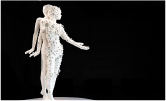 Principles & vision
Principles & vision
 Procurement
Procurement
 Sustainability for the Yaskawa Group
Sustainability for the Yaskawa Group
 Customer satisfaction
Customer satisfaction
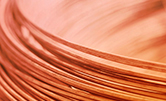 Supply chain
Supply chain
 Social contribution
Social contribution
 Compliance & risk management
Compliance & risk management







